Whether you have your sights set firmly on world domination, or if you simply want to share your experience and ideas with like-minded individuals, blogging could be exactly what you or your business needs.
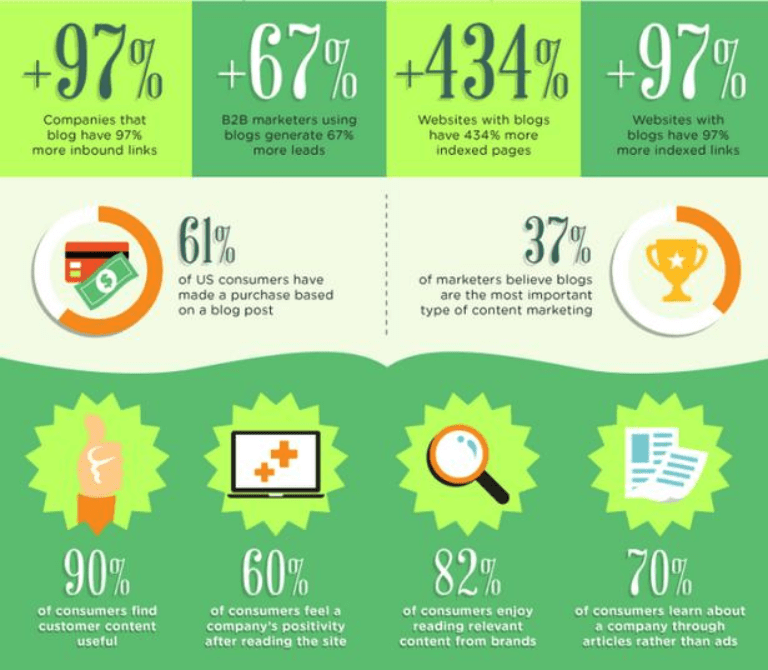
(Reasons to be cheerful: Some figures that show the importance of blogging. Image Source: SEO Chart)
So you’re thinking of becoming a blogger. Great! There are very few means of gaining exposure for your personal brand or business online than through creating organic content for audiences.
In an interconnected world that’s driven by search engine results pages from the likes of Google, Bing and Yahoo!, written content has held as much power as it does today. With every article you produce, you have the opportunity to utilise keywords to help make your work more discoverable to search engine users. By anticipating the sort of terms that your potential readers will be searching for, you have the ability to position your content right under the noses of those who matter most.
Of course, the wide world of blogging extends way beyond SEO, and for many users, the reward can be found in the act of blogging itself. And many there are: there’s an estimated 500 million blogs in the world today – that’s a fair portion of competitors and potential friendships to forge within a dynamic and ever-creative industry.
Given that there are so many blogs active across the world, users are rewarded for searching harder to find niche subjects to cover and to avoid treading on other bloggers’ toes as it were. With this in mind, it pays to throw rule books and guides out of the window in order to find your own styles, idiosyncrasies and motivations. It may seem a little counterintuitive to carry on reading our guide following the last sentence! But we aim to focus on helping you get into a position to start blogging based on statistics and industry insights – we’re not ones for telling you what to think or blocking your creativity.
By stepping into the world of blogging, you’re about to enter into an environment that’s immensely rewarding and surprisingly therapeutic for many users – not to mention it being an immensely powerful place to help your businesses’ website take off and get the traffic it deserves.
So, without further ado, welcome to our step by step guide for writing a successful blog post! Sit back, and enjoy:
1. How To Get Blog Post Ideas
You’ve created your blog, and built your digital space to suit the type of content that you’re planning on producing. Now, it’s time to channel your excitement and passion for writing into gaining some invaluable ideas for your posts.
Of course, there’s no right or wrong way to write blog posts for fun. There is, however, a right and wrong way to produce content for Search Engine Optimisation purposes. In 201, you could write two posts that are alike in tone and length – only for one to be 10 times more successful than the other due to better use of keywords.
Essentially, you need to take a moment to think of who your target audience would be. Who’s going to most enjoy reading your blog?
It’s vital that you make your blog posts visible to your target audience, and so you’ll need to utilise the type of keywords that they’ll be putting into Google when searching for content.
There are plenty of ways for you to check out which keywords would be of most interest to prospective readers, and tools like Google Trends are great for gauging how many recurring searches are conducted for specific sets of words.

Another great tool comes in the form of Keywords Everywhere. This particular tool comes in the form of a free Google Chrome add-on that adds things like ‘search volume’ charts, ‘CPC and ‘competition data’ automatically to websites. Alternatively, if you have a Google Ads account, Google’s Keyword Planner makes for an excellent way of discovering which keywords are most heavily searched for and how many websites have already utilised specific words and phrases. However, it’s pretty limited if you’re not actually spending money on Google Ads.
But, what we always recommend using for keyword research is Ahrefs Keyword Explorer:
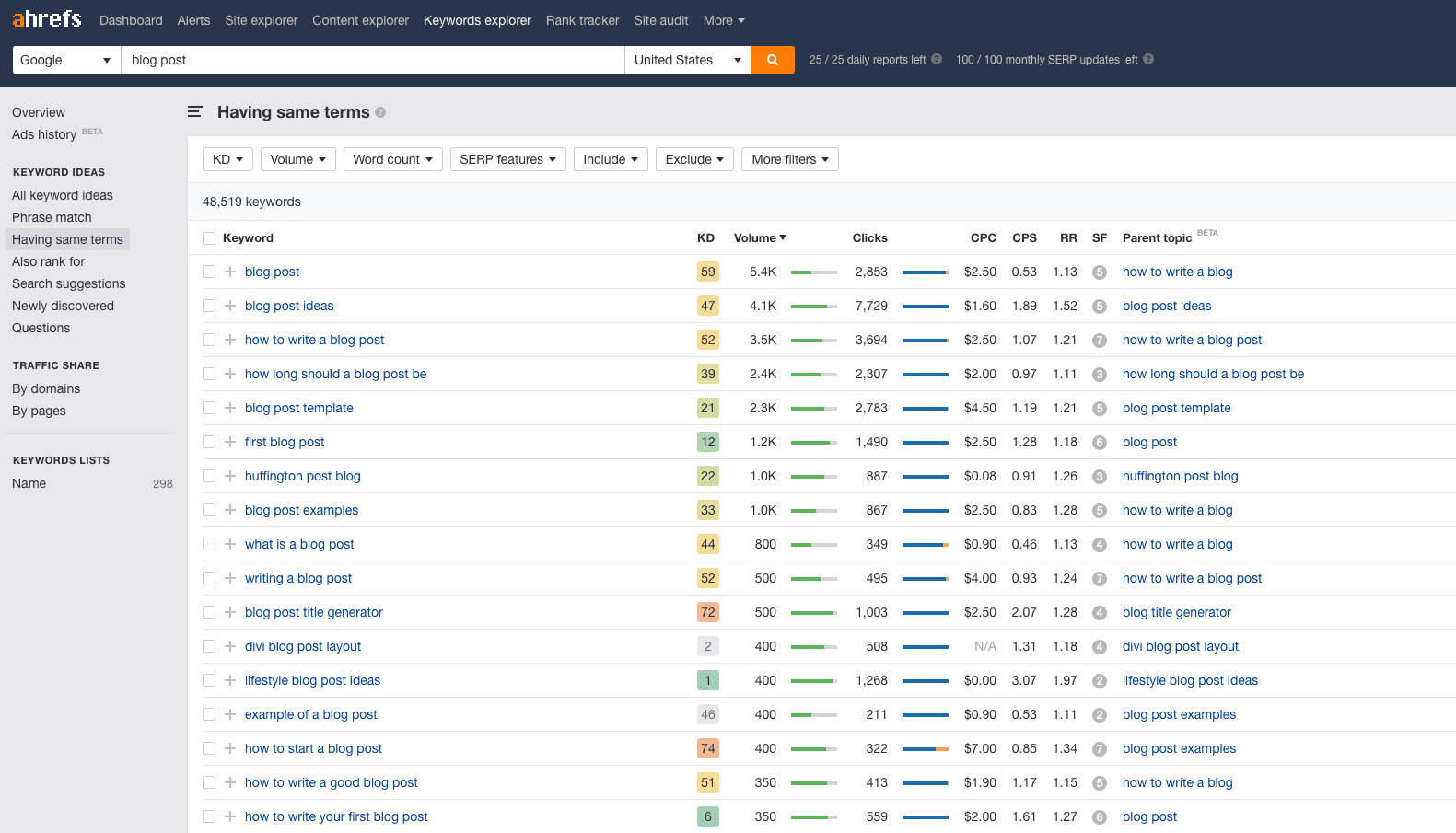
Fundamentally, when internet users utilise the likes of Google, they’re looking for answers to queries. One excellent way of coming up with ideas for blog posts is through anticipating the sort of questions that your target audience will be asking. If you’re a business owner, take a look at your products or services and aim to solve every question a prospective customer could have within your content.
If you’re looking for inspiration as a business owner, it could be an idea to directly ask customers about what they need help with, or employees about the recurring questions that prospects are asking.
You could also look across the internet for inspiration from your competitors. Take a look at the sort of existing blog posts that regularly gain attention from your prospective readership and try to figure out how you could repurpose your work in order to provide similarly engaging content.
It’s imperative that you avoid plagiarism, and there’s no greater crime in the world of blogging than stealing someone else’s hard work for your own website. However, there’s great value to be found in finding good ideas that already exist online and endeavouring to make your content on the topic even better than any competition out there. Use tools like Grammarly to check your work for typos and plagiarism.

If you’re looking to create a post that’s more left-field than anything that exists online at present, you could find that there’s plenty of opportunities for producing organic content within the conducting of interviews. By looking for a voice of authority on a relevant subject, you could gain deep insights and build great credibility for readers by drawing on a strong external voice within your pages.
Don’t be afraid to get personal in your posts also. Drawing on personal experience in your posts can help you to become more familiar and relatable to your audience. Although it’s important to maintain an air of objectiveness in your content, conveying your personality in your blog posts can build a level of personability that many large and more corporate blogs could never emulate.
When you’ve ventured into the world of blogging, you can also gain invaluable inspiration based on which of your previous blog posts have been more successful in the past. If a post from two months ago is still gaining visitor traffic and comments, then you may want to consider looking deeper into the topics covered and expanding on them further – this could make your content into something evergreen, that keeps users interested in visiting your site many months and years into the future.
Of course, we live in a society that’s focused on convenience, and as such, you’re never too far from an automated tool that’s ready and able to do your dirty work for you. If you happen to be stumped for quality content to come up with then tools like Hubspot’s Blog Ideas Generator can be a perfect source of topics relevant to your site. Simply input a noun to get started and the generator creates countless potential subjects to cover that’ll be a sure-fire hit for your readers.
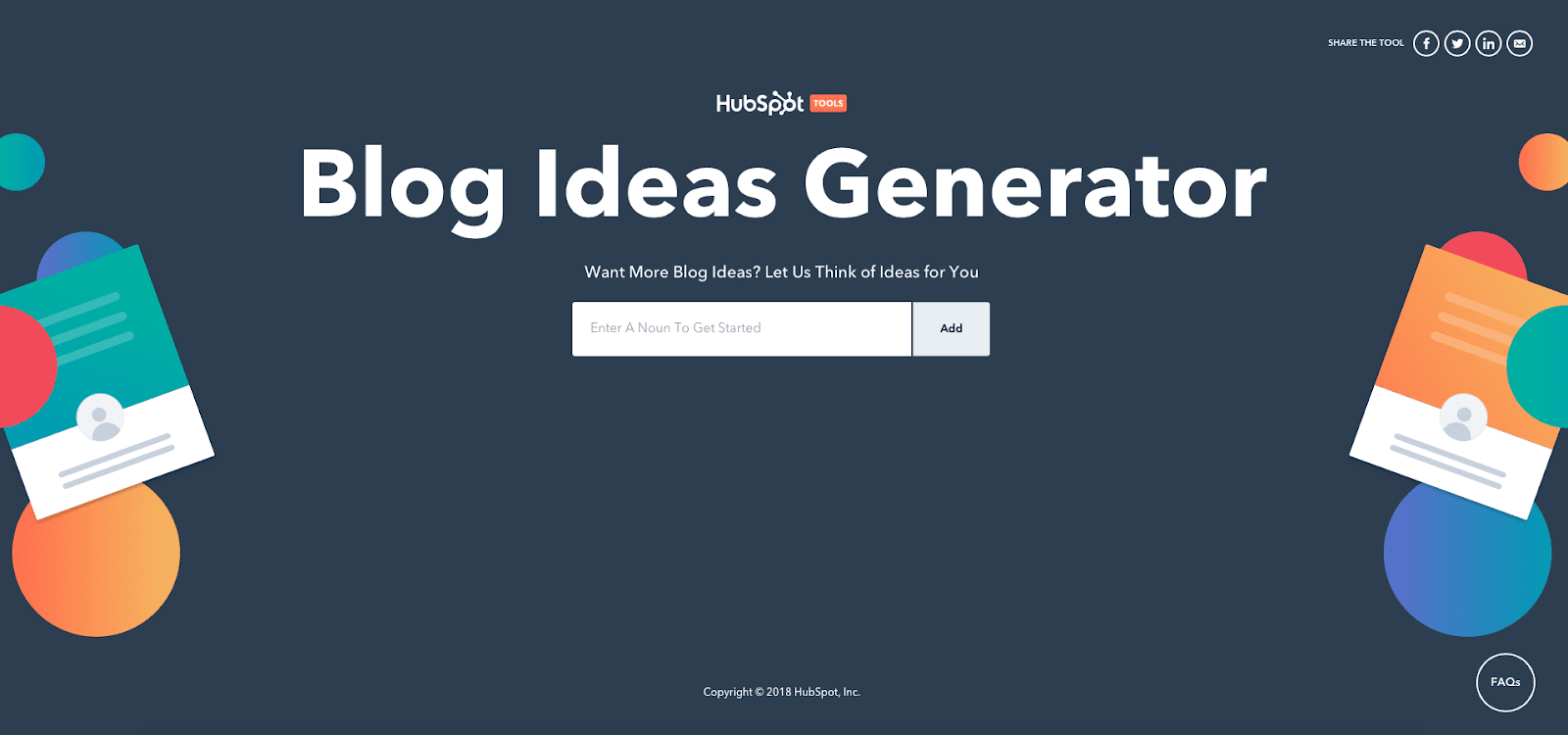
2. How To Write a Blog Post
Once you’ve come up with a good idea then the magic can really begin to happen. There are plenty of blogging platforms that are centred on providing excellent levels of convenience to bloggers regardless of their level of experience in order to allow them to create and publish posts effortlessly. Platforms like WordPress, Blogger and Tumblr are particularly effective in bringing convenience to users.
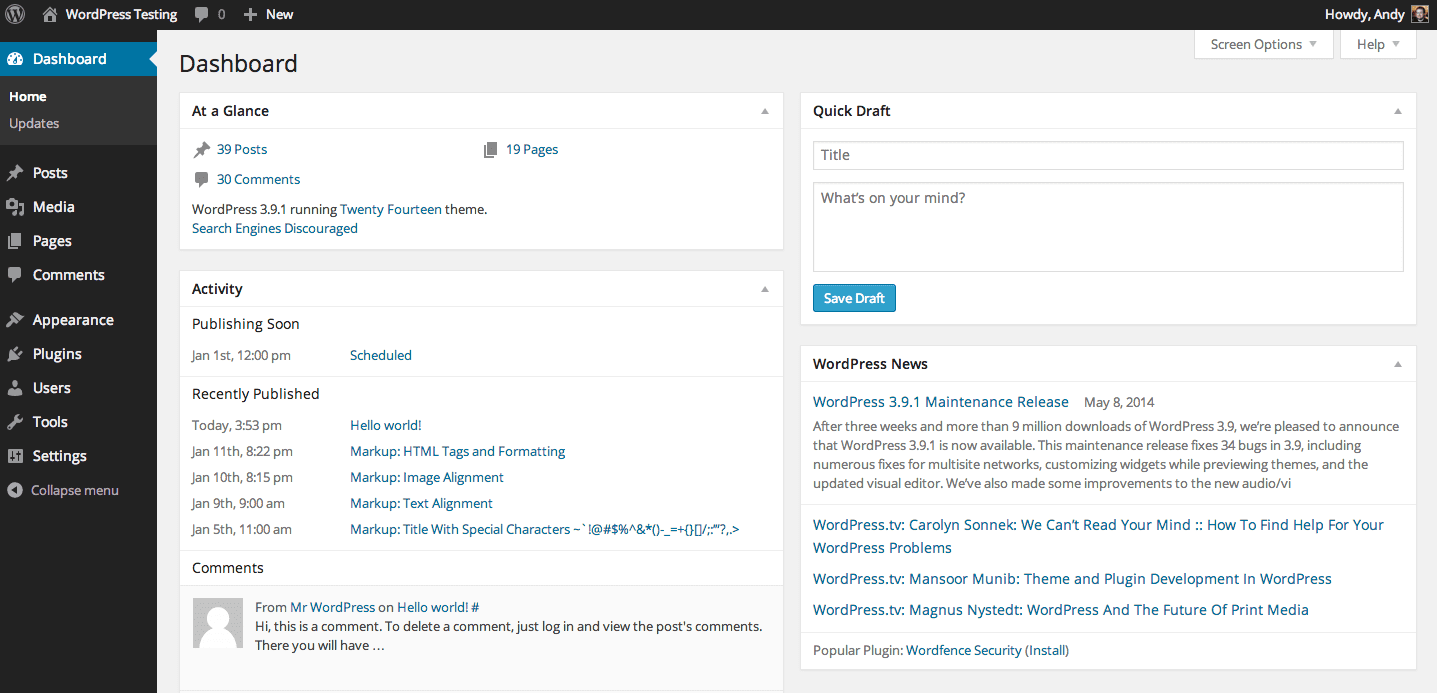
Of course, using these platforms you can easily dive in, write to your heart’s content, and publish posts in a matter of minutes – but there’s a difference between writing a blog post and creating engaging content.
An effective, SEO infused title is a great place to start, although some experienced bloggers may prefer to create their content before deciding on an appropriate title that summarises the direction that their post takes retroactively.
Remember to create a title that’ll be discoverable on the pages of Google. If you’re a pet shop, a title like ‘Why Whiskas is good for your cat’ might make for an honest headline, it’ll likely struggle to rank highly – whereas a title like ‘Seven of the best cat food flavours that your Moggy will love’ covers searchable topics like “best cat food” and “cat food flavours” which could ultimately be significant in gaining your blog invaluable search ranking positions.
No pressure, but usually your introductory paragraph is essential in encouraging readers to continue scrolling through your post or clicking back to Google. People have a spectacularly short attention span in 2021, so you’ll need to knock it out of the park early on.
Be sure to construct an engaging, enthralling opening paragraph that helps to explain what your readers are about to encounter.
It’s important to spend time considering the tone and style of your blog. Many users simply write posts as if they’re blogging for themselves. Of course, there’s nothing necessarily wrong with creating content with yourself in mind, and it may prove to be a hit with like-minded readers, but if you’re intent on producing posts that’ll be loved by your target audience, it’s vital that you get into their heads and spend time considering their feelings.
If you’re writing blog posts on behalf of your business, then it’s good practice to convey a tone that’s formal and complements your industry expertise. As a professional organisation, you’ll want to act as a voice of authority on a subject – writing in perpetual slang or carrying a conversational manner might be a good way of making yourself more relatable as an author, but you may have a harder time convincing your readership that you’re a voice of authority.
When you decide on the tone that you want your blog to carry, make sure that you rarely deviate from this writing style. Returning users will want to feel comfortable and familiar with your blog and website – continually shifting your house styles will cause visitors to feel detached from your brand or authorship.
It’s imperative that you make your content SEO ready. This means that you should be constantly on the lookout for infusing keywords into your writing. Keep reminding yourself of the sort of terms users will be searching for when looking to discover your work, and look to include potential search topics within your work.
SEO extends well beyond the passages that you write. On all good blogging platforms, you have the opportunity to edit your page’s SEO. This extends to appropriate tagging, page descriptions and URLs. Below is a short list of things to keep on the lookout for:
URL: Search engines like Google look at your blog page’s URL to figure out what your post is all about. Luckily platforms like WordPress include the option of editing your blog post’s URL to make it easier for Google’s little bots to suss out. Be sure to spend a moment considering how to optimise your URL in a way that keeps it descriptive and discoverable.
Meta Tags: Like with URLs, meta titles and meta descriptions help to describe your content to search engines and visitors alike. If your post appears on the results pages of Google, users will be presented with a meta tag followed by a few sentences that tell them all about the page that they’ll be navigating on to. Again, be sure to use some valuable keywords to appeal to your target audience and secure that all-important click.
Tags: Most blogging platforms give you the chance to include tags to accompany your post. HubSpot suggests that you choose between 15-25 relevant tags that help tell potential visitors about the type of content covered within your post. Just make sure that each tag is suitably different from one another. Using words like ‘cat’ and ‘cats’ may be accurate for your cat food blog, but that doesn’t help much when it comes to for the user to decide which tag to navigate to.
While we’re on the topic of On-Page SEO, be sure to utilise internal linking within your content. Doing so helps search engines recognise the validity and relevance of your content. Not to mention, internal linking can work wonders for your website traffic by encouraging visitors to read more of your work.
The same logic applies for external links away from your website. External linking not only helps Google to figure out exactly what your content is all about, but also helps you to avoid getting exposed for plagiarism by referencing wherever you’ve sourced your information – a key factor of blogging etiquette.
Although there are many more On-Page and Technical SEO factors to consider (website speed, caching, meta robots, sitemaps, blog’s structure, etc.), the above should be treated as basics of any blog post.
3. How Long Should a Blog Post Be
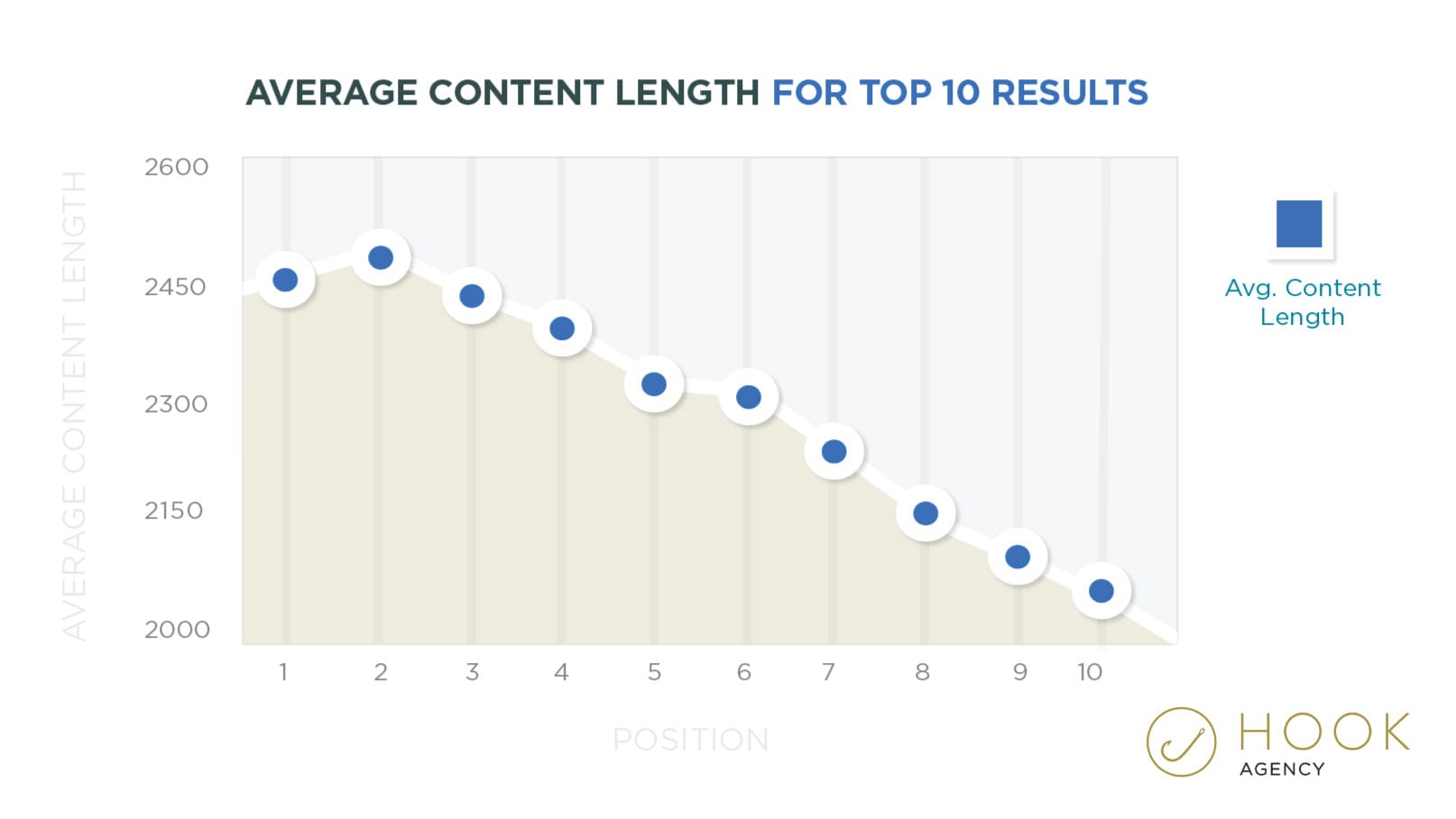
(Chart showing the importance of getting the content length just right for your SEO. Image Source: Hook)
If you’re blogging with the intention of gaining exposure for yourself or your business, then it might be worth looking at the correlation between the length of the typical articles that are commonly found on the front pages of Google.
As you can see from the graph, the average length of a piece of content that’s regularly featured at the very top spot of Google’s results pages stands at around 2,450 words. The further down the top ten rankings you go, the lower the word count becomes.
Typically in the world of blogging, authors favour shorter, punchier, more pictorial posts. While this is a good means of ensuring that your output is as prolific as possible, it’s likely that you won’t be seeing your publications appearing at the top of search engine results pages any time soon (unless you’re BBC or The Guardian).
It’s theorised that longer blog posts have more opportunities for organic keywords to be positioned in your content. If your article is 2,000 words long, there’s plenty of potential searchable topics within the body of your text.
Just because the typical length of front page content on Google stands at around 1,900 words, this doesn’t mean that you should write verbose, empty content. It’s advisable to take the idea of the ‘perfect word count’ with a pinch of salt when creating a blog post.
Simply remember that you’re writing for your audience, not Google. Remember to enjoy your writing, keep it informative, and entertain your readers. If you find yourself clogging up your word count for the sake of it, you’ll not only end up waffling on but could run the risk of putting-off your readers. Remember, always opt for quality over quantity.
It’s worth remembering that it’s potentially beneficial to produce longer articles even if you’re used to creating multimedia blog posts. If you like to publish videos or audio on your blog, be sure to include transcripts or supporting content around your piece. This will not only help your visibility on search engines but will also make your publications more accessible for readers who aren’t in a position to watch or listen to your content (i.e. on their commute, or have no access to headphones).
4. Blog Post Examples
Sometimes it’s a little bit easier to learn visually, rather than listen to us waffle on, so we thought it may be useful to include some visual examples of great blog posts to help you along.

Here, HubSpot shows us a strong example of an optimised title (although a bit longer than the recommended length of up to 60 characters).
The highlighted part of the heading shows us the ‘title tag’ of the piece – usually a short punchy and relevant tagline. In this case, HubSpot is targeting a few key phrases:
- On-Page SEO
- SEO
- Keyword Optimizing

This example shows us how to effectively optimise our URL for SEO purposes. The address of this particular page is informative and as short as can be in length. Below the URL we can see an excellent meta description that’s brief and informative for anybody looking to locate your content via Google (although a bit short if you ask me).

The above intro has been plucked from our own site (well we were always going to back ourselves as the experts, weren’t we!). The intro emphasises the importance of standing out from the crowd while providing an element of supportive mise-en-scene for the article.
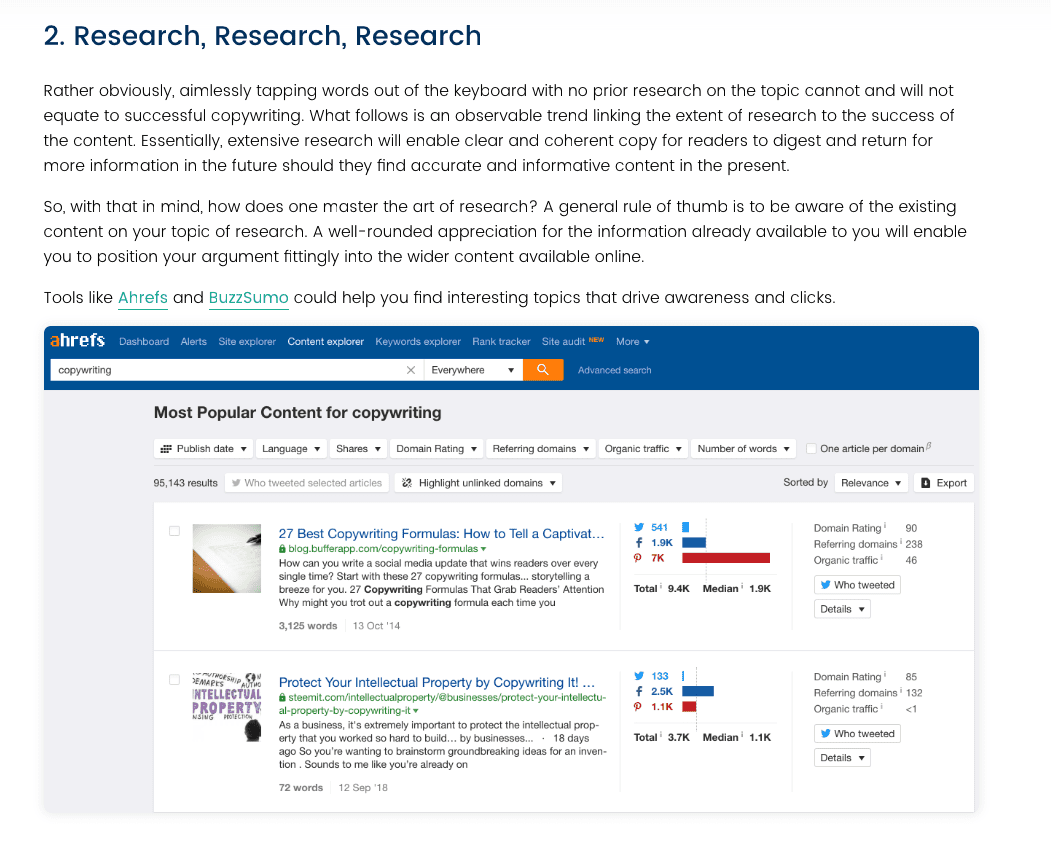
The above body of text dabbles in a range of popular practises online. Firstly, the content is broken down into digestible headings that prevent the reader from having to process large swathes of text without an appropriate break or respite.
There’s also a couple of relevant links embedded into the text. This not only helps to give credit where it’s due to referring websites but stands as a helping hand that can transport readers swiftly to the external websites that are being discussed.
Finally, the passage of text concludes with a relevant screenshot to help further illustrate the point that’s being made. Once again, images are important for readers because they help to enable audiences to take a break from the body of text on the screen.

Here’s an example of a conclusion. The final paragraphs of your blog posts provide you with the chance to momentarily break from any formal writing styles you may have adopted for the main body of your text. Depending on your audience, it could be worth becoming considerably more conversational and even inviting them to share their thoughts and opinions in the comments section of your page.
Now, it’s time to conclude our own step-by-step guide! Remember, that there’s no right or wrong way of creating a blog and publishing posts. The best practice for bloggers is to take a moment to get into the minds of their intended audience: who are they? What do they like? How would they like to be talked to?
Remember that best-ranking blog posts typically range from 1,900 words to 2,500, and are well keyworded – but never compromise quality for quantity when it comes to producing posts.
Above all, make sure you have fun when producing blog posts! It’s simply not worthwhile if you see the process as nothing but a chore. It’s pretty special that you’re contributing to the zeitgeist in such a creative way. So sit back, relax, and enjoy your venture into the exciting world of blogging – but most importantly, don’t forget to meta tag your content!
Blog Post FAQ
[sc_fs_multi_faq headline-0=”h3″ question-0=”What is a blog?” answer-0=”A blog is a website or platform within a site that enables writers to publish content as frequently as they would like. The style can be either formal or informal and can be text-based or tuned more towards multimedia.” image-0=”” headline-1=”h3″ question-1=”How easy is it to write a blog post?” answer-1=”It’s easy to write a blog post, but not so straightforward to optimise it. Websites like WordPress have become popular blogging platforms over time and allow users to create content in a matter of clicks. However, to get your post to rank, you’ll need to do a little bit of research and incorporate relevant keywords to make it more discoverable on search engines.” image-1=”” headline-2=”h3″ question-2=”How long should my blog post be?” answer-2=”A blog post can be as long as you want it to be. However, if you’re aiming to give your content the best chance of getting onto the front page of Google, the highest-ranking articles are typically around 2,450 words long.” image-2=”” headline-3=”h3″ question-3=”How can blog content help businesses?” answer-3=”If a business features a quality and frequently maintained blog section, its content has a strong chance of having its keywords picked up by search engines – enabling its site to rank higher within the results pages of Google, for example.” image-3=”” count=”4″ html=”true” css_class=””]
